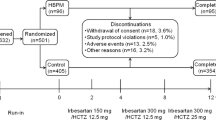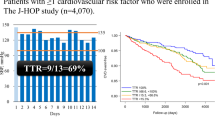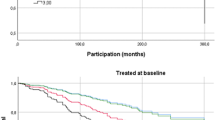Abstract
The aim of this study was to assess whether the use of 24-h blood pressure (BP) measurement in the management of antihypertensive therapy improves BP in patients with sustained hypertension. Patients with sustained hypertension (office BP ⩾140/90 mm Hg, and 24-h systolic BP ⩾130/80 mm Hg) were randomly assigned to a strategy using 24-h BP to manage antihypertensive treatment (target <130/80 mm Hg) or to a standard strategy using office BP (target <140/90 mm Hg). The primary end point was change in 24-h systolic BP at 1 year of follow-up. We included 136 patients in the primary analysis. After 1 year of follow-up, the change in 24-h systolic BP was significantly greater in the ambulatory BP group compared with the office BP group (mean difference (95% confidence interval) −3.6 (−7.0, −0.3), P=0.03). Intention-to-treat analysis revealed essentially unchanged results. The mean number of antihypertensive drugs per participant at 1 year of follow-up was 1.76±1.1 and 1.95±0.9 in the ambulatory and office BP group, respectively (P=0.049). The benefit of ambulatory BP monitoring was mainly seen in patients with previously known hypertension (mean difference −7.2 (−11.6, −2.8), P=0.002), but not in those with newly detected hypertension (mean difference 0.2 (−4.9, 5.4), P=0.93). In conclusion, using 24-h BP for the management of antihypertensive therapy in patients with sustained hypertension leads to a greater BP reduction compared with a standard treatment strategy using office BP, although fewer antihypertensive drugs were used in the ambulatory BP group.
This is a preview of subscription content, access via your institution
Access options
Subscribe to this journal
Receive 12 digital issues and online access to articles
$119.00 per year
only $9.92 per issue
Buy this article
- Purchase on Springer Link
- Instant access to full article PDF
Prices may be subject to local taxes which are calculated during checkout


Similar content being viewed by others
References
Mancia G, De Backer G, Dominiczak A, Cifkova R, Fagard R, Germano G et al. 2007 guidelines for the management of arterial hypertension: the task force for the management of arterial hypertension of the European Society of Hypertension (ESH) and of the European Society of Cardiology (ESC). J Hypertens 2007; 25: 1105–1187.
Chobanian AV, Bakris GL, Black HR, Cushman WC, Green LA, Izzo Jr JL et al. The Seventh Report of the Joint National Committee on Prevention, Detection, Evaluation, and Treatment of High Blood Pressure: The JNC 7 Report. JAMA 2003; 289: 2560–2571.
Mansoor GA, McCabe EJ, White WB . Long-term reproducibility of ambulatory blood pressure. J Hypertens 1994; 12: 703–708.
Pickering TG, James GD, Boddie C, Harshfield GA, Blank S, Laragh JH . How common is white coat hypertension? JAMA 1988; 259: 225–228.
Verdecchia P . Prognostic value of ambulatory blood pressure: current evidence and clinical implications. Hypertension 2000; 35: 844–851.
Verdecchia P, Porcellati C, Schillaci G, Borgioni C, Ciucci A, Battistelli M et al. Ambulatory blood pressure. An independent predictor of prognosis in essential hypertension. Hypertension 1994; 24: 793–801.
Conen D, Martina B, Perruchoud AP, Leimenstoll BM . High prevalence of newly detected hypertension in hospitalized patients: the value of inhospital 24-h blood pressure measurement. J Hypertens 2006; 24: 301–306.
Clement DL, De Buyzere ML, De Bacquer DA, de Leeuw PW, Duprez DA, Fagard RH et al. Prognostic value of ambulatory blood-pressure recordings in patients with treated hypertension. N Engl J Med 2003; 348: 2407–2415.
Dolan E, Stanton A, Thijs L, Hinedi K, Atkins N, McClory S et al. Superiority of ambulatory over clinic blood pressure measurement in predicting mortality: The Dublin Outcome Study. Hypertension 2005; 46: 156–161.
Staessen JA, Thijs L, Fagard R, O'Brien ET, Clement D, De Leeuw PW et al. Predicting cardiovascular risk using conventional vs ambulatory blood pressure in older patients with systolic hypertension. JAMA 1999; 282: 539–546.
Bjorklund K, Lind L, Zethelius B, Berglund L, Lithell H . Prognostic significance of 24-h ambulatory blood pressure characteristics for cardiovascular morbidity in a population of elderly men. J Hypertens 2004; 22: 1691–1697.
Hansen TW, Jeppesen J, Rasmussen S, Ibsen H, Torp-Pedersen C . Ambulatory blood pressure monitoring and risk of cardiovascular disease: a population based study. Am J Hypertens 2006; 19: 243–250.
Mancia G, Bombelli M, Facchetti R, Madotto F, Corrao G, Trevano FQ et al. Long-term prognostic value of blood pressure variability in the general population: results of the Pressioni Arteriose Monitorate e Loro Associazioni Study. Hypertension 2007; 49: 1265–1270.
Kikuya M, Ohkubo T, Asayama K, Metoki H, Obara T, Saito S et al. Ambulatory blood pressure and 10-year risk of cardiovascular and noncardiovascular mortality: The Ohasama Study. Hypertension 2005; 45: 240–245.
Conen D, Bamberg F . Noninvasive 24-h ambulatory blood pressure and cardiovascular disease: a systematic review and meta-analysis. J Hypertens 2008; 26: 1290–1299.
Staessen JA, Byttebier G, Buntinx F, Celis H, O'Brien ET, Fagard R . Antihypertensive treatment based on conventional or ambulatory blood pressure measurement. A randomized controlled trial. Ambulatory Blood Pressure Monitoring and Treatment of Hypertension Investigators. JAMA 1997; 278: 1065–1072.
Bjorklund K, Lind L, Zethelius B, Andren B, Lithell H . Isolated ambulatory hypertension predicts cardiovascular morbidity in elderly men. Circulation 2003; 107: 1297–1302.
Ohkubo T, Kikuya M, Metoki H, Asayama K, Obara T, Hashimoto J et al. Prognosis of ‘masked’ hypertension and ‘white-coat’ hypertension detected by 24-h ambulatory blood pressure monitoring: 10-Year follow-up from the Ohasama study. J Am Coll Cardiol 2005; 46: 508–515.
El Assaad MA, Topouchian JA, Asmar RG . Evaluation of two devices for self-measurement of blood pressure according to the international protocol: the Omron M5-I and the Omron 705IT. Blood Press Monit 2003; 8: 127–133.
Jones CR, Taylor K, Chowienczyk P, Poston L, Shennan AH . A validation of the Mobil O Graph (version 12) ambulatory blood pressure monitor. Blood Press Monit 2000; 5: 233–238.
O'Brien E, Mee F, Atkins N, O'Malley K . Accuracy of the SpaceLabs 90207 determined by the British Hypertension Society protocol. J Hypertens 1991; 9: 573–574.
Palatini P, Dorigatti F, Mugellini A, Spagnuolo V, Vari N, Ferrara R et al. Ambulatory versus clinic blood pressure for the assessment of anti hypertensive efficacy in clinical trials: insights from the Val-Syst Study. Clin Ther 2004; 26: 1436–1445.
Staessen JA, Den Hond E, Celis H, Fagard R, Keary L, Vandenhoven G et al. Antihypertensive treatment based on blood pressure measurement at home or in the physician's office: a randomized controlled trial. JAMA 2004; 291: 955–964.
Verberk WJ, Kroon AA, Lenders JW, Kessels AG, van Montfrans GA, Smit AJ et al. Self-measurement of blood pressure at home reduces the need for antihypertensive drugs: a randomized, controlled trial. Hypertension 2007; 50: 1019–1025.
Niiranen TJ, Kantola IM, Vesalainen R, Johansson J, Ruuska MJ . A comparison of home measurement and ambulatory monitoring of blood pressure in the adjustment of antihypertensive treatment. Am J Hypertens 2006; 19: 468–474.
Ohkubo T, Hozawa A, Yamaguchi J, Kikuya M, Ohmori K, Michimata M et al. Prognostic significance of the nocturnal decline in blood pressure in individuals with and without high 24-h blood pressure: the Ohasama study. J Hypertens 2002; 20: 2183–2189.
Ben-Dov IZ, Kark JD, Ben-Ishay D, Mekler J, Ben-Arie L, Bursztyn M . Predictors of all-cause mortality in clinical ambulatory monitoring: unique aspects of blood pressure during sleep. Hypertension 2007; 49: 1235–1241.
Boggia J, Li Y, Thijs L, Hansen TW, Kikuya M, Bjorklund-Bodegard K et al. Prognostic accuracy of day versus night ambulatory blood pressure: a cohort study. Lancet 2007; 370: 1219–1229.
Lewington S, Clarke R, Qizilbash N, Peto R, Collins R . Age-specific relevance of usual blood pressure to vascular mortality: a meta-analysis of individual data for one million adults in 61 prospective studies. Lancet 2002; 360: 1903–1913.
Turnbull F . Effects of different blood-pressure-lowering regimens on major cardiovascular events: results of prospectively-designed overviews of randomised trials. Lancet 2003; 362: 1527–1535.
Iskedjian M, Einarson TR, MacKeigan LD, Shear N, Addis A, Mittmann N et al. Relationship between daily dose frequency and adherence to antihypertensive pharmacotherapy: evidence from a meta-analysis. Clin Ther 2002; 24: 302–316.
Staessen JA, Wang J, Bianchi G, Birkenhager WH . Essential hypertension. Lancet 2003; 361: 1629–1641.
Kikuya M, Hansen TW, Thijs L, Bjorklund-Bodegard K, Kuznetsova T, Ohkubo T et al. Diagnostic thresholds for ambulatory blood pressure monitoring based on 10-year cardiovascular risk. Circulation 2007; 115: 2145–2152.
Acknowledgements
We thank Dr Robert J Glynn for statistical advice. This study was supported by unrestricted grants from Bayer Pharma, Zurich, Switzerland and Boehringer-Ingelheim, Basel, Switzerland. NCT00139984 (http://www.clinicaltrials.gov/ct/show/NCT00139984). David Conen was supported by grants from the Swiss National Science Foundation (PASMA 118586/1), the Janggen-Poehn Foundation, St Gallen, Switzerland and the Stiftung für Gesundheit und kardio-/neurovaskuläre Forschung, Basel, Switzerland.
Author information
Authors and Affiliations
Corresponding author
Additional information
Disclosure
David Conen and Peter Tschudi have no financial disclosures. Benedict Martina has served as a consultant to Boehringer-Ingelheim and has received honoraria from Boehringer-Ingelheim, Novartis and Merck Sharp & Dohme.
Rights and permissions
About this article
Cite this article
Conen, D., Tschudi, P. & Martina, B. Twenty-four hour ambulatory blood pressure for the management of antihypertensive treatment: a randomized controlled trial. J Hum Hypertens 23, 122–129 (2009). https://doi.org/10.1038/jhh.2008.106
Received:
Revised:
Accepted:
Published:
Issue Date:
DOI: https://doi.org/10.1038/jhh.2008.106
Keywords
This article is cited by
-
Shared decision-making in antihypertensive therapy: a cluster randomised controlled trial
BMC Family Practice (2013)
-
Blood pressure management in a cohort of hypertensive patients in Germany treated by cardiologists
Clinical Research in Cardiology (2011)
-
Editors choice: recent highlights from the journal of human hypertension
Journal of Human Hypertension (2010)



